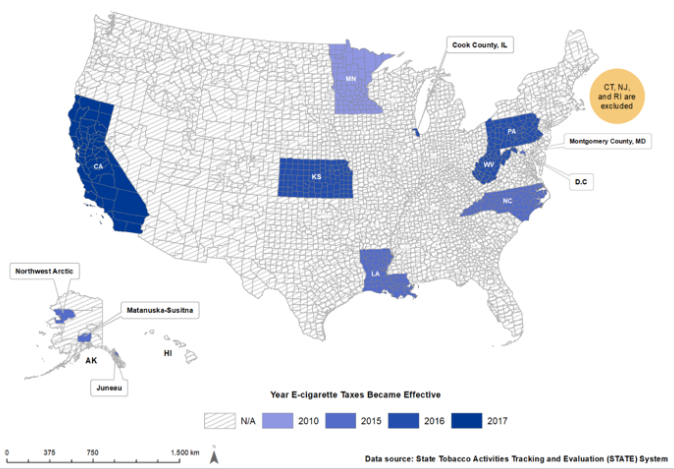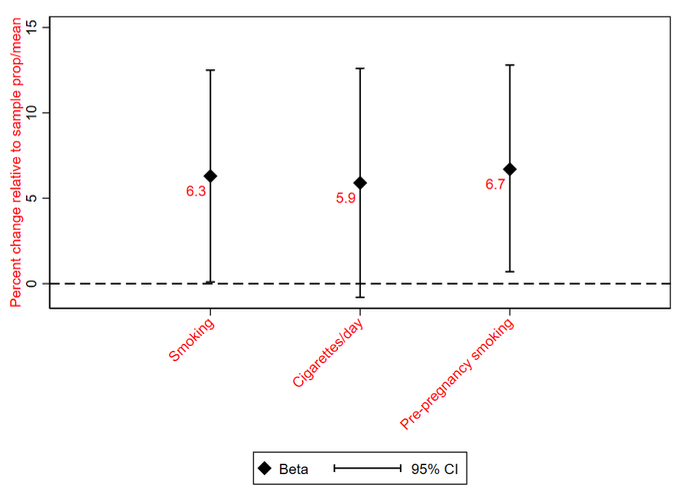Electronic cigarettes (‘e-cigarettes’) were developed in China in 2003 and first imported to the US in 2006, where they have become increasingly popular, especially among young Americans. The adult e-cigarette regular use rate was 2.8% in 2017 (3.3% for men and 2.4% for women) (Wang et al. 2018). Vaping rates are even higher among young people. In 2019, 27.5% of high school students reported using an e-cigarette in the past 30 days, up from only 0.6% in 2011 (Food and Drug Administration 2019). Over that same period, traditional cigarette smoking rates declined dramatically among young people from 15.8% in 2011 to 5.8% in 2019, or 66% (Food and Drug Administration 2019).
While popular, e-cigarettes are controversial products, with vocal advocates and critics. They have aroused substantial debate within the scientific community about whether vaping improves or harms population health. A commonly stated benefit of vaping among advocates is that e-cigarettes are a healthier way to consume nicotine – the addictive ingredient in tobacco products – for smokers unable to quit. This argument, often referred to as ‘harm reduction,’ received added credence from the Surgeon General of the US, who concluded that while e-cigarettes are not harmless, they generally contain fewer toxicants than traditional cigarettes (US Department of Health and Human Services 2016). There is also evidence that e-cigarettes may allow some smokers to fully quit tobacco products. For instance, a recent large-scale randomized control trial in England found that e-cigarettes are twice as effective for cessation purposes as nicotine replacement therapies (NRTs), often viewed as the gold standard quitting method (Hajek et al. 2019). Harm reduction and cessation benefits are potentially important, as 14% of adult Americans continue to smoke despite well-established health harms (Wang et al. 2018). Smoking is responsible for more than 480,000 deaths each year (Centers for Disease Control and Prevention 2017), and 68% of current smokers want to quit but cannot as smoking is highly additive (Babb 2017).
On the other hand, e-cigarette critics contend that the harm reduction and cessation benefits of these products are overstated, and that vaping itself is harmful to health (Ribisl et al. 2016). A rash of recent and unexplained vaping-related lung illnesses and deaths across the US have heightened such concerns, although early evidence indicates that most patients were using vaping products containing tetrahydrocannabinol (THC), the principal psychoactive ingredient of marijuana, rather than nicotine (Centers for Disease Control and Prevention 2019). E-cigarette critics also contend that these products may serve as a ‘gateway’ to traditional cigarette use for young people (US Department of Health and Human Services 2016). However, the rapid decline of traditional cigarette-use rates that occurred while e-cigarette use was rising does not support this theory and suggests that e-cigarettes may prevent smoking among young people.
Given this backdrop of uncertainty, we examine the effects of e-cigarette taxes on smoking outcomes in a particularly important group: pregnant women. While the health harms of smoking to the foetus during pregnancy are well-known, and this behaviour is strongly discouraged by healthcare professionals, government data show a disconcerting story: 45% of women smoking three months before their pregnancy are unable to quit smoking for the duration of pregnancy (Centers for Disease Control and Prevention 2016). Pregnant women who cannot quit smoking may turn to e-cigarettes for help in cessation attempts, thereby substituting a (potentially) less harmful nicotine consumption device for the duration of their pregnancy. Indeed, survey data document that pregnant women perceive e-cigarettes to be less harmful to the foetus than traditional cigarettes, and helpful in efforts to quit smoking (Wagner et al. 2017, Mark et al. 2015).
In a recent paper (Abouk et al. 2019), we examine the effect that state e-cigarette tax adoption has on pre-pregnancy and prenatal smoking, and on standard birth outcome measures such as birth weight and gestational length. E-cigarette taxes are expected to increase the store price of these products and thereby reduce their use among price-responsive consumers. In this sense, we can estimate the effect of e-cigarette use for those consumers who change their vaping habits in response to the tax-induced price increase. Taxing e-cigarettes could increase or decrease pre-pregnancy and prenatal smoking. If e-cigarettes and traditional cigarettes are substitutes among pregnant women, then an e-cigarette tax should increase smoking as consumers switch to traditional cigarettes when the price of e-cigarettes rises. Alternatively, if e-cigarettes and traditional cigarettes are complements (i.e. goods used in conjunction with one another), then taxing e-cigarettes should decrease both vaping and smoking. The extent to which an e-cigarette tax will influence birth outcomes is less clear. According to the US Surgeon General, e-cigarettes contain fewer toxicants than traditional cigarettes, but both products contain nicotine, which poses harm to the foetus (Committee on Obstetric Practice 2017, Holbrook 2016). Medical evidence suggests worse birth outcomes for women who use either product (Whittington et al. 2018).
To study the effects of e-cigarette taxes on pre-pregnancy and prenatal smoking, as well as birth outcomes, we use comprehensive records on the universe of births in the US over the period 2013 to 2017. Our analysis sample includes over 17 million births. As of March 2017, the end of our study period, 15 US states, counties, and cities had adopted an e-cigarette tax. Figure 1 reports the adopting localities graphically. We use a powerful econometric technique referred to as differences-in-differences (Angrist and Pischke 2009) to recover the causal effect of e-cigarette taxes on studied outcomes. This technique compares changes in smoking rates and birth outcomes between localities that adopt and do not adopt an e-cigarette tax before and after the tax adoption, holding all other factors constant.
Figure 1 Localities that levied an e-cigarette tax as of March 2017
Notes: Data sources are the Vapor Products Tax Data Center, American Non-Smokers Rights Foundation (proprietary), and Tax Foundation.
Our study has two main findings:
- E-cigarette taxes increase traditional cigarette smoking among pregnant women, with the substantial share of the increased smoking occurring in the pre-pregnancy period and carrying through to the prenatal period (see Figure 2). For example, after an e-cigarette tax is adopted, smoking rates increase among pregnant women by 0.3 percentage points or 6.3% (relative to the proportion of women who smoke in our sample). This suggests that e-cigarettes and traditional cigarettes are substitutes for pregnant women.
Figure 2 Effect of e-cigarette taxes levied at conception on any prenatal smoking
Notes: Data source is administrative birth records with geocodes provided by the National Center for Health Statistics, January 2013 to March 2017. N=17,269,246. The unit of observation is a pregnancy in a county in a state. All models are estimated with a linear probability and control for an indicator variable coded ‘one’ if a locality adopted an e-cigarette tax and ‘zero’ otherwise; mothers’ demographics; county-fixed effects (i.e. a separate indicator for each county); conception year-by-month fixed effects (i.e. a separate indicator for each conception year-month pair); and conception state-by-year fixed effects (i.e. a separate indicator for each conception state-by-year pair). Black diamonds represent the coefficient estimate for any e-cigarette tax indicator variable, and vertical lines represent the 95% confidence interval. Coefficient estimates and 95% confidence intervals are converted to percent changes by comparing the estimated value with the baseline proportion in localities that adopted an e-cigarette tax by March 2017 in the time prior to tax adoption.
- E-cigarette taxes do not appear to influence any of the birth outcomes we study, which suggests that pregnant women who use nicotine products – either e-cigarettes or traditional cigarettes – face worse birth outcomes than those who do not use these products while pregnant. Our study does not speak to the potentially improved health for the pregnant woman herself if she uses e-cigarettes instead of traditional cigarettes, or later-life outcomes for her child if the mother remains traditional cigarette-free and the child is thus exposed to less secondhand smoke.
While our study does not speak to the overall value of e-cigarettes to the US public, it does imply that using e-cigarettes instead of traditional cigarettes for pregnant women will not likely improve their infant’s birth outcomes. Further, our study suggests a potential unintended consequence of regulating e-cigarettes: reduced rates of cessation of traditional cigarettes among pregnant women, or worse, increased smoking within this population.
Meanwhile, e-cigarette regulations are on the rise. Eight additional states have passed e-cigarette taxes in 2018 and 2019 alone. San Francisco recently banned the sale of e-cigarettes entirely (Siegel 2019). In September 2019, Michigan and New York announced plans to ban the sale of e-cigarettes (Associated Press 2019). Somewhat oddly, none of these bans, adopted or proposed, affects traditional cigarettes. Further, President Trump recently stated that he is seeking to ban the sale of flavoured e-cigarettes as a means to curb what has been termed a “youth vaping epidemic” by the US Surgeon General (Vazquez and Klein 2019). Our results encourage decision makers embarking on aggressive regulation of e-cigarettes to consider that such regulations may harden the preference for smoking.
References
Abouk, R, S Adams, B Feng, J C Maclean and M F Pesko (2019), "The Effect of E-Cigarette Taxes on Pre-Pregnancy and Prenatal Smoking, and Birth Outcomes", NBER Working Paper No. 26126.
Angrist, J D and J Pischke (2009), Mostly Harmless Econometrics: An Empiricist's Companion. Princeton, NJ: Princeton University Press.
Associated Press (2019), "Michigan Joins New York in Banning Sale of Flavored E-cigarettes Amid Vaping Health Concerns".
Babb, (2017), "Quitting smoking among adults—United States, 2000–2015", MMWR: Morbidity and Mortality Weekly Report 65.
Centers for Disease Control and Prevention (2016), "Information for Health Care Providers and Public Health Professionals: Preventing Tobacco Use During Pregnancy".
Centers for Disease Control and Prevention (2017), "Smoking & tobacco use: Diseases and death", Fast Facts Atlanta, GA: Centers for Disease Control and Prevention.
Centers for Disease Control and Prevention (2019), "Outbreak of Lung Injury Associated with E-Cigarette Use, or Vaping", Atlanta, GA: Centers for Disease Control and Prevention.
Committee on Obstetric Practice (2017), "Committee Opinion No. 721: Smoking Cessation During Pregnancy", Obstetrics and Gynecology 130 (4):e200.
Food and Drug Administration (2019), "Trump Administration Combating Epidemic of Youth E-Cigarette Use with Plan to Clear Market of Unauthorized, Non-Tobacco-Flavored E-Cigarette Products".
Hajek, P, A Phillips-Waller, D Przulj, F Pesola, K M Smith, N Bisal, J Li, S Parrott, P Sasieni and L Dawkins (2019), "A randomized trial of e-cigarettes versus nicotine-replacement therapy", New England Journal of Medicine 380 (7):629-637.
Holbrook, B D (2016), "The effects of nicotine on human fetal development", Birth Defects Research Part C: Embryo Today: Reviews 108 (2):181-192.
Mark, K S, B Farquhar, M S Chisolm, V H Coleman-Cowger and M Terplan (2015), "Knowledge, attitudes, and practice of electronic cigarette use among pregnant women", Journal of Addiction Medicine 9 (4):266-272.
Ribisl, K M, A B Seidenberg and E N Orlan (2016), "Recommendations for us public policies regulating electronic cigarettes", Journal of Policy Analysis and Management 35 (2):479-489.
Siegel, R (2019), "San Francisco becomes first major U.S. city to ban e-cigarette sales to combat teen vaping", Washington Post, accessed 26 September 2019.
U.S. Department of Health and Human Services (2016), "E-Cigarette Use Among Youth and Young Adults: A Report of the Surgeon General", Rockville, MD: U.S. Department of Health and Human Services.
Vazquez, M and B Klein (2019), "Trump administration moves to ban flavored e-cigarettes", CNN, accessed 26 September 2019.
Wagner, N J, M Camerota and C Propper (2017), "Prevalence and perceptions of electronic cigarette use during pregnancy", Maternal and Child Health Journal 21 (8):1655-1661.
Wang, T W, K Asman, A S Gentzke, K A Cullen, E Holder-Hayes, C Reyes-Guzman, A Jamal, L Neff and B A King (2018), "Tobacco product use among adults—United States, 2017", Morbidity and Mortality Weekly Report 67 (44):1225.
Whittington, J R, P M Simmons, A M Phillips, S K Gammill, R Cen, E F Magann and V M Cardenas (2018), "The Use of Electronic Cigarettes in Pregnancy: A Review of the Literature", Obstetrical & Gynecological Survey 73 (9):544-549.










